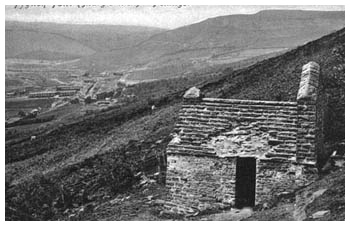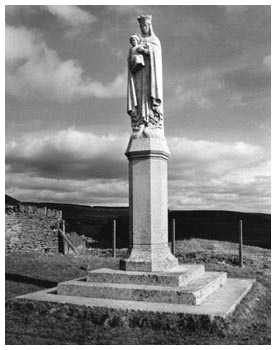
| Penrhys | |
Looking today at the hilltop of Penrhys dominated as it is by a 1960's council housing development and the greens and fairways of the Rhondda Golf Club it is difficult to imagine the richness of history and legend connected with this small part of the Rhondda. No other part of the Rhondda can compare in this manner to that of Penrhys. Some indicators of that richness of heritage remain in the small brick building that houses Mary's Well and in the statue of Mary that looks out over the Rhondda Fawr. However of the medieval monastery and buildings that once dominated the hilltop there is barely a trace. Despite the fact that as late as the 1840's some portions of the monastery still existed, though in large part incorporated with buildings of the farm that then existed on the site. The farm had largely used materials from the monastery's remains in its construction. In particular in its barn was found, during an excavation in 1912, a 30 foot intricately carved beam which had come from a building of 'some prominence'. |
|
| Legends & traditions associated with Penrhys | |
| Early legends tell of a Franciscan monastery at Penrhys, built on the site as a memorial to the Welsh Prince Rhys Ap Tewdwr, who was said to have been beheaded near there. Legends tell how Rhys fought a battle with Iestyn Ap Gwrgant who was supported by the Normans. After being defeated Rhys fled, but was overtaken and taken prisoner and beheaded. Later his grandson, Robert of Gloucester, a donor to abbeys at Margam and Neath was said to have founded the monastery ay Penrhys in Rhys' memory, during the reign of Henry I between 1130 and 1132. Later historians have cast doubts upon this version of events, claiming Rhys' death did not in fact take place at Penrhys. Also at the date of the death of Robert Consul, the Franciscan Order had not been founded. In actuality the monastery was most probably a possession of the Cistercian monks at Llantarnam Abbey in Monmouthshire. However it was founded, what is clear is that the monastery existed and thrived on the site for the next 300 years, and the estate even boasted a 'taverne house', no doubt to cater for the pilgrims visiting it's shrine. It is said that the monastery was dissolved and its possessions were sold by Henry V, as a punishment for supporting the cause of Owain Glyndwr in the 15th Century. Owain himself, so legends tell, presided at an eisteddfod at the site in the early fourteen hundreds. If so the site must have been soon restored as a place of worship and pilgrimage. For in 1538, during the dissolution of the monasteries, the Chancellor, Thomas Cromwell, specifically earmarked the statue of Mary at the shrine for destruction along with other important religious statues such as the ones at Walshingham. |
|
FFYNON MAIR, Mary's Well |
|
| Sited just below the crest of the mountain at Penrhys stands the small nondescript stone 'hut-like' structure known as Mary's well. This unassuming building houses the spring that has been the focus of religious life at Penrhys, dating back to the earliest days of Christianity in the Rhondda. This spring has throughout its recorded history been attributed with miraculous healing powers said to be of divine origins. Research suggests that the spring's focus as a place of worship and healing, actually pre-dates Christianity, and is actually of pagan origin. | |
| In common with many springs of this nature pagans believed it to be a dwelling place of divinities and thus possessing mystical powers. Christian missionaries on discovering such superstitions attached to a spring such as this at Penrhys, would endeavour to subvert these traditions, placing the responsibility for the 'miraculous powers' associated with them as being of Christian origin. Thus the spring at Penrhys became dedicated to Mary, and the healing attributes became a gift from God to the righteous. The spring was said to be effacious in curing many ailments, such as 'rheumatism, king's evil' and particularly eye disorders. In addition the spring waters for many years were used in baptisms at the local parish church. Penrhys was what is known colloquially as a 'pin well' as the person hoping to be healed would, after taking the waters, cast a pin into the well. If the pin became discoloured it was a sign that their petition would be granted. It is said that even in the twentieth century 'scores of pins' were often to be found lying in the well. |
Marys Well - Penrhys |
| The statue of 'Our lady' of Penrhys | |
Our Lady of Penrhys circa 1997 |
The original statue at Penrhys was said to be 'indescribably beautiful', and contained 'Mary nursing Jesus for a kiss'. Much smaller that the statue that currently resides at Penrhys it was thought to have originally been placed in an alcove at the small well chapel. Legends tell that the original statue was a gift from heaven, which miraculously appeared in the branches of an oak tree at the site. The statue, it is said, resisted all attempts to move it from the tree so that, 'eight oxen could not have drawn the Image of Penrhys from its place in the tree'. The statue only allowed itself to be moved when a shrine and chapel were built to house it. The original statue survived at Penrhys until the 1500's, and Henry Viii's dissolution of the monasteries. At this time Bishop Latimer wrote to Thomas Cromwell suggesting the destruction of a number of Shrines of Our Lady, believing them to be a focus of idolatry, and thus 'the devil's instrument'. The statue at Penrhys at this time was obviously an important one as it, alongside others such as the one at Walsingham and Ipswich, was mentioned by name in this letter
|
| When Ferndale church was built a Miss M.M. Davies of Llantrisant procured for the church a replica of the original statue, carved in oak standing in a tree trunk. The statue that currently stands on the hillside at Penrhys was erected in 1953, and blessed by Archbishop McGrath on the 2nd July that year. The statue was carved out of Portland stone and designed, using the many description of the original statue contained in medieval welsh poetry, to resemble the original as closely as possible. |
|
Pilgrimages to Penrhys |
|
| The traditions of pilgrimage dates back hundreds of years, and were a major industry in medieval times. Penrhys' note as a healing well made it a major centre for pilgrimage and religious devotion. Some say it was second only to David's in terms of religious significance. Because of its popularity, the original religious buildings were expanded to cater for the number of visitors to the shrine, and a ' taverne house' was erected at the site. At Penrhys the pilgrims tended to be, on the most part common folk, but pilgrims from all classes and walks of life made the journey to the shrine. One of Wales' most famous medieval poets Gwilym Tew describes, 'lines of upturned faces…as the priests administered holy communion'. It was common for pilgrims to leave valuable gifts at the shrine and decorate the Statue with gifts of jewellery and 'gold plate'. The most common of devotional gifts from the pilgrims however was of tapers or candles, 'often as tall and heavy as themselves'. Much medieval poetry survives to this day detailing the pilgrimages and the shrine at Penrhys and the processions of the sick of every class and station. After the dissolution of the monasteries, and despite barely a trace of the original shrine and building remaining, records show that Penrhys still attracted (albeit in much smaller numbers than previously) the devotion of pilgrims up to the nineteenth century. When the Reverend P..J O'Relliy Gibbons came to Ferndale as parish priest in 1936 he revived the tradition of pilgrimage to Penrhys. After the erection of the new statue in 1953, an estimated 20-25,000 attended the first pilgrimage to the shrine. The Church of England attended their first pilgrimage to the shrine in May 1976. Then in May 1977 there was the first pilgrimage of the sick to Penrhys since the reformation, which over 2,000 people attended. Thus a religious tradition that dates back as much as eight hundred years still continues today in the Rhondda. |
|
Penrhys smallpox hospital |
|
| When the Rhondda first became the industrialised valley that we are all familiar with today health and sanitary conditions were, by today's standards appalling, Life expectancy was low, infant mortality high and the cramped, insanitary conditions meant that outbreaks of communicable diseases were common occurrences. Thus in 1904, despite the existence in Ystrad of a 'fever hospital', the Medical Officer of Health of the Rhondda in his Annual Report stated the urgent need for a separate small-pox hospital. Small-pox at that time being one of the most virulent, highly contagious diseases known. Subsequent to this report in 1906 the local council chose a site at Penrhys as the location for this new hospital, and the Rhondda Urban district Council's Health Committee purchased three acres of land from Penrhys-Isaf farm. The site at Penrhys was chosen both for accessibility to both Rhondda Fach and Rhondda Fawr, straddling as it does the mountainside between the two. Additionally its isolated position made it ideal for an isolation hospital, being at least four hundred yards from the nearest dwellings of Penrhys Uchaf and Penrhys Isaf farms. The Medical Officer's Annual report gives the official estimate for the setting up of the hospital as being, 'including land, foundations, drainage, buildings, fittings, furniture, water supply, and boundary fence', approximately £35,000. The work on the hospital was completed towards the end of the following year. The hospital served firstly the communities of the Rhondda and latterly all of South Wales for over sixty years. When the building was deemed surplus to requirements in the 1970's it had to be razed to the ground by the South Wales Fire service in 1971, to totally destroy any viruses still present on the site. |
|

